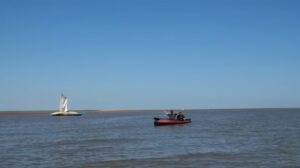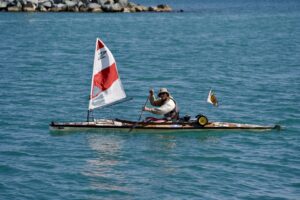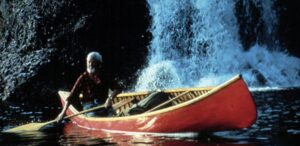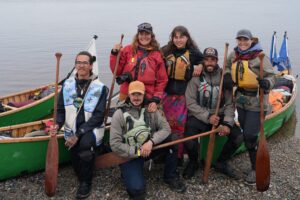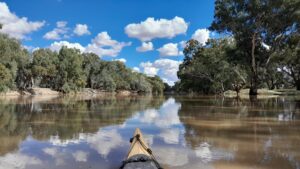On May 7, 26-year-old Madison Eklund left Minneapolis to kayak 2,400km alone to Hudson Bay, in the Canadian north. Her journey will cross through Minnesota, South Dakota, North Dakota, and span most of Manitoba.
ExWeb caught up with the young paddler to learn what motivates her, how she prepared for what she calls Expedition Alpine, and how the trip’s going so far.

Eklund’s route began in Minneapolis, Minnesota, and will end in Hudson Bay. Image: M. Eklund
To the best of Eklund’s knowledge, hers is the fourth expedition to pursue the Minneapolis to Hudson Bay line, but the first solo.
Those previous paddling expeditions were:
- Eric Sevareid and Walter Port, 1930
- Sean Bloomfield and Colton Witte, 2008
- Natalie Warren and Anna Raiho, 2011
A handful of other voyages have taken a similar route but departed from the Grand Portage/Boundary Waters area of Lake Superior instead of Minneapolis’s entry to the Minnesota River. Both routes begin to overlap at Lake Winnipeg.
The interview has been edited for brevity and clarity.
Last we heard, you’d passed the “century” (100-mile) mark on your voyage. Congratulations! How’s it going so far?
At this point, I’m well past my century mark, and actually almost done with the 315 miles [563km] of the Minnesota River. I’d be further, but I had to spend two weeks off the river due to severe flooding and debris in the river.
The trip has been a blast so far, and I’m really looking forward to the next leg, where I’m going with the current!
First soloist
You’re following the route charted by Sevareid and Port in 1930 and you’ll be the first soloist to do this route. But why choose this one over any other route that hasn’t been soloed?
Honestly, this was never about being the first soloist on this route. It just kind of evolved into that.
My now-husband was stationed out here with the military. We did the long-distance thing for a while, and I lived in the mountains of Upstate New York. I was an extremely active hiker, climber, and kayaker while I lived there. When I planned on moving out here to join him, I knew I’d be losing the mountains, forests, and in a way, a part of myself.
I started thinking about a long-distance kayaking trip since I knew there was a river right through town. At first, I considered doing an end-to-end of the Red River. I started researching the area and found that the Red River flows into Lake Winnipeg to the north, and has a tributary [Bois De Sioux River] to the south. Once I started talking to the locals about doing a South Dakota-to-Manitoba trip, several mentioned a much larger historic trip that was recently done by two women: Minneapolis to the Hudson Bay.
I looked it up and was really impressed. I read every single blog post [from the expedition members], looked at their maps, and researched each of the water features they traveled on. Natalie Warren of the Warren/Raiho expedition had an upcoming book release event, so I went. In the meantime, I purchased Canoeing with the Cree and Adventure North. I read both and connected with Warren at the event.
The more I learned about this trip, the more I could see myself doing it. It was my kind of crazy.
I was pretty sure the trip would be solo. It’s hard to find someone skilled who is also interested and willing to take the time off/save up the finances to go on a crazy trip for up to four months. A partner also adds a very different dynamic to the trip. It’s one more person who you have to worry about safety and well-being for. One more person where you need to be aware of their skill levels and deficiencies…you always have to travel at the pace of your slowest group member.
I did genuinely look for a partner for this trip but ultimately could not find one. I’m very comfortable on my own in the backcountry, so it’s not that big of a deal for me.

Photo: Madison Eklund
Kayaking background
Could you give us some idea of your kayaking experience?
I first kayaked around the age of seven at my grandparent’s summer home in Maine and fell in love! I’d spend each summer bombing around on the lake in one of two older Perception Acadias that we would borrow from the neighbors.
At some point, I tried to fly the idea of circumnavigating the island [on the lake] by my parents and grandparents. It caused quite a fight! I explained that the neighbor’s son had done it, and then was forbidden to go.
My dad came to console me later that night and asked, “What’s stopping you? Take your sister and some supplies, and leave at sunrise before everyone has their coffee. Text me periodically, and I’ll keep everything under control here.”
Long story short, my sister and I completed the trip. She slept for the rest of the week and vowed never to go again. I was hooked and made it a yearly trip!
Since then, I’ve kayaked regularly. I also completed some challenging hiking/backpacking trips that were several days long and I lived out of my two-door Wrangler for four months in the mountains, so being without a house or bed isn’t an issue.
First long-distance expedition
However, this will be my first truly long-distance trip. I’ve worked to acquire any skills I may need. I’ve been working on learning to roll my kayak. I have tons of first aid/medical training already but brushed up on that as well. I also volunteer for our regional swiftwater search and rescue, so I’ve been able to get an idea of where issues arise and how paddlers can put themselves in danger.
Unfortunately, I’m not as experienced as I’d like to be in whitewater. There is quite a bit of that on the northern reaches of my trip. I’ve studied up as much as I can, but theory is very different from experience. All the classes I signed up for were canceled because of COVID. This is the one area where I plan on being extremely cautious. I fully intend to walk many of the rapids because of my lack of knowledge, even though portages can be long, overgrown, and buggy.
With all this being said, it’s important to keep in mind that all three prior trips were done by people fresh out of high school, and two of the three had minimal whitewater experience themselves.

Photo: Madison Eklund
Polar bear safety
Are you at all concerned about encounters with predatory animals? Polar bears are known to show up inland on Hudson Bay. Are you carrying any form of animal deterrent or self-defense?
Yes, I am a bit wary of polar bears and maybe wolves. I’ve also been told that grizzly bears are slowly making a comeback into northern Manitoba.
I have bear spray and an electric bear fence for my campsites. My dad also sent me a flare gun.
I plan on being strategic with food storage and cooking times. Preventing any interest in your camp is much simpler than preventing death from an attack. Overall, I will only be inside the polar bears’ range for a short period of time. Previous trips did not see any at all, only the girls’ trip saw one being chased by a groundskeeper at York Factory [in Hudson Bay].
Animals are also quite predictable. They generally fear humans and only want their food/territory/safety. If you don’t provoke them and give them plenty of space and respect, there is generally no issue.

Photo: Madison Eklund
Minimal new equipment
What about gear? Can you tell us a bit about your kayak and any of the ancillary equipment that you think will be especially vital to the trip?
This was an area where I really hoped to limit my carbon footprint for this trip. New products and clothing carry such a heavy environmental burden. They consume a lot of water and energy to produce. It’s really important to use what you have first. With that being said, I did get some items I needed for the trip.
My kayak is a Wilderness Systems Tempest 170 (17 feet long, roughly 56 pounds). It’s a bit heavy for portages, but these rotomolded plastic boats are extremely durable and can take quite a beating. I opted to deal with the extra weight to give me some safety and wiggle room because I lack experience with whitewater. A punctured boat up there could mean serious trouble, and many others have had to call for help in that same situation. Additionally, Lake Winnipeg can get some rough water where you can actually bottom out on rock reefs up to a mile from shore between the swells. This is a capsize risk, but also a boat-damage risk.
I purchased a Garmin Inreach Explorer…[and] I also bought a solar panel. This will supplement my battery packs and charging frequently at town stops along the way.
Follow Expedition Alpine
For trip reports, updates, and more, head to expeditionalpine.com and follow Eklund on Facebook and Instagram.


